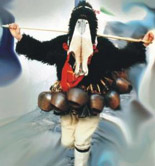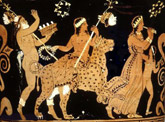Special Issue: Carnival Season in Greece |  |
- Special Issue: Carnival Season in Greece
- Carnival & the Cities
- Traditional Festivities
- "Clean Monday"
- Greek News Agenda Readers
| Special Issue: Carnival Season in Greece Posted: 04 Mar 2011 03:23 AM PST  Greece's Carnival season known as "Apokries" is a period of eating, drinking, dancing, and masquerading for the young and the young in spirit. Greece's Carnival season known as "Apokries" is a period of eating, drinking, dancing, and masquerading for the young and the young in spirit. Traditionally, it begins ten weeks before Greek Orthodox Easter and culminates on the weekend before "Clean Monday," (Ash Monday) the first day of Lent. This year, the carnival season lasts from February 12 until March 7. Literally "Apokria" means 'saying' goodbye to the period of meat-eating, or abstinence from meat (Apo-kreo = away from meat). The roots of Carnival celebrations and customs can be traced back to ancient Greece and are linked to the worship of Dionysus, the Greek god of wine and festivity. The processions, costuming, and feasting all derive from ancient ceremonies honoring him and other Greek gods and goddesses.
 Carnival officially begins on a Saturday evening with the "opening of the Triodion," as it is called metaphorically. Carnival officially begins on a Saturday evening with the "opening of the Triodion," as it is called metaphorically. Triodion -also Lenten Triodion- is a liturgical book of the Orthodox Church that contains hymns with three odes instead of nine and begins to be chanted on the Sunday of the Publican and the Pharisee through Holy Saturday, marking the launch of the three week pre-Lenten Season. The following week is a fast-free week until Meatfare Sunday which is the last day before Easter for eating meat.  The Thursday of this week is known as Tsiknopempti -Charred, Smoky or Barbeque Thursday- because of the smell of the grilled meat in the air. Tsiknopempti is the Greek version of Fat Thursday during which family and friends gather in tavernas or homes to eat large quantities of charred meat and celebrate, just ten days before the beginning of Lent. The Thursday of this week is known as Tsiknopempti -Charred, Smoky or Barbeque Thursday- because of the smell of the grilled meat in the air. Tsiknopempti is the Greek version of Fat Thursday during which family and friends gather in tavernas or homes to eat large quantities of charred meat and celebrate, just ten days before the beginning of Lent. The last Sunday of the Carnival period is known as Cheesefare Sunday or Tyrofagos as only dairy products can be consumed on this day. Cheesefare Sunday is the final day of pre-Lent, as the Monday following -known as Clean or Ash Monday- marks the beginning of Great Lent. During the weekend preceding Clean Monday, carnival celebrations around Greece culminate with vigorous parades, masquerade parties, reviving many traditional customs in different parts of the country, and proving that carnival in Greece is closely related to the cultural heritage of each region. |
| Posted: 04 Mar 2011 04:19 AM PST The port city of Patras hosts the biggest carnival in Greece, and one of the biggest in Europe. The "king" of Greek carnivals begins in January with an announcement by the town crier, and reaches its peak in the last weekend of carnival. The Patras carnival features a variety of events: balls, parades, a Treasure Hunt (with approximately seventy carnival groups participating), a Children's Carnival (that attracts approximately 12,000 children), street theatre, and much more. But mostly the Patras carnival is the tens of thousands carnival-goers of all ages, participating spontaneously to the formal or informal events taking place in homes, bars or in the street, turning the whole city into a gigantic party.
 The Thracian city of Xanthi hosts one of the most popular carnivals in the country. The Thracian city of Xanthi hosts one of the most popular carnivals in the country. The Xanthi carnival started in 1966 as an urban event but has incorporated many traditional elements, based on the city's multicultural character, that renders it the most folkish of urban carnivals.  The highlight is the Folk Parade on Saturday before Ash Monday: bringing together cultural associations from all of Greece, the troupes go singing and dancing through the neighbourhoods of the picturesque Old Town and merge in an all-night Balkan folk music fiesta in the main square. The highlight is the Folk Parade on Saturday before Ash Monday: bringing together cultural associations from all of Greece, the troupes go singing and dancing through the neighbourhoods of the picturesque Old Town and merge in an all-night Balkan folk music fiesta in the main square. Cheesefare Sunday leads to the custom of Burning the tzaros, a human effigy placed on top of a pile of brushwood. This old Thracian custom takes place atop the Kosynthos River Bridge; tradition has it that burning the tzaros will keep away the fleas during the summer months.
 Venetian tradition meets Cretan folklore and ancient practices in beautiful renaissance Rethymno. "Air," has been chosen as this year's carnival celebration theme in an attempt to send out a clear ecological message. Venetian tradition meets Cretan folklore and ancient practices in beautiful renaissance Rethymno. "Air," has been chosen as this year's carnival celebration theme in an attempt to send out a clear ecological message. More than 15.000 revelers are expected to participate in the float parade of March 6, which is the culmination of the celebrations that last an entire month. The celebrated Treasure Hunt and Bel Canto serenades give away the carnival's Venetian roots but carnival customs practiced in the villages near Rethymno city, e.g the "moutzouroma" (daubing), the "klepsimo tis nyfis"(stealing of the bride), are undeniable proof that Dionysus is alive and kicking in Crete! |
| Posted: 04 Mar 2011 03:24 AM PST
This centuries old custom incorporates folk and historical elements, as it ceremonially re-enacts Ottoman era conflicts. Contrary to the disarray that dominates most Carnivals, Naoussa's customs are characterised by exceptional aesthetic and ritual discipline, with participants adorned in elegant minimalistic masks and silver coin plastrons that are ritually sown on the "janissary" throughout the night.
This largely Dionysian celebration culminates on Ash Monday and involves phallic replicas, indecent language and gestures, ribald carnival songs, as well as lots of the excellent local tsipouro (often drank from phallic shaped vessels). These (unsuitable for the easily offended) festivities stop when the evening bell for church rings, as such behaviour is no longer permitted.
 The carnival in the Aegean island of Skyros comes alive with the sounds of clanging goat bells. These are worn around the waists of the island men who take part in the carnival playing the role of geros (old man), a figure dressed in a hooded black cape and hanging goat skin. The carnival in the Aegean island of Skyros comes alive with the sounds of clanging goat bells. These are worn around the waists of the island men who take part in the carnival playing the role of geros (old man), a figure dressed in a hooded black cape and hanging goat skin. The "old men" run through the streets individually or in groups, singing, dancing and making as much noise as possible, while locals and guests must always toast, drink and dance with the "old man."
 While burning King Carnival is a widespread custom around Greece, the people of Zakynthos have a more ceremonial tradition to say farewell to the masquerade. While burning King Carnival is a widespread custom around Greece, the people of Zakynthos have a more ceremonial tradition to say farewell to the masquerade. Following the island's rich and Venetian-type carnival of Giostra (that features chivalric fights), the last Sunday brings the Funeral of the Mask or Povero Carnival: the carnival marchers lead the Masked King – placed in a colourful coffin – to his resting place in a magnificent funerary procession that reaches the harbour. |
| Posted: 04 Mar 2011 03:44 AM PST
Children make Kyra Sarakosti (Lady Lent), a paper doll with seven legs to represent the seven weeks of Lent. Every week, a leg is cut off to show how many weeks remain until Easter. Since it marks the beginning of the fasting period special food is eaten on this day. Eating red meat, poultry, fish or dairy products is not permitted.  However, a host of other dishes and delicacies is available: lagana (a special unleavened bread eaten only on this day), taramasalata (a fish roe spread), dolmadakia (vine leaves stuffed with rice), grilled octopus, gigantes plaki (oven-baked broad beans), seafood salads and shellfish as well as a special semolina pudding known as halvas are just some of them. However, a host of other dishes and delicacies is available: lagana (a special unleavened bread eaten only on this day), taramasalata (a fish roe spread), dolmadakia (vine leaves stuffed with rice), grilled octopus, gigantes plaki (oven-baked broad beans), seafood salads and shellfish as well as a special semolina pudding known as halvas are just some of them. A variety of more sophisticated recipes for 'Clean Monday dishes' is available at Kerasma.
 On the northern coast of the Corinth Gulf in Fokida Prefecture, the town of Galaxidi is one of Greece's top destinations especially during the carnival season. On the northern coast of the Corinth Gulf in Fokida Prefecture, the town of Galaxidi is one of Greece's top destinations especially during the carnival season. The picturesque small town impresses visitors with its tranquil charm and its rich maritime heritage, notably the old captains' mansions ("kapetanospita"). A stroll on the seaside promenade between the harbors of Oianthi and Hirolaka, and through the narrow alleyways is definitely a must.  During Carnival, the town revives the unique custom of "alevromoutzouromata" dating back to the heyday of the town's merchant fleet, as a fun event for departing sailors at the end of the Carnival. During Carnival, the town revives the unique custom of "alevromoutzouromata" dating back to the heyday of the town's merchant fleet, as a fun event for departing sailors at the end of the Carnival. On Clean Monday, Galaxidi is transformed into a battlefield as hundreds of people pelt mercilessly one another with ample quantities of variously coloured flour and dance around the fires – the most daring even jump over them! You Tube: Flour Fighting in Galaxidi; Athens Plus: Fokida: Come and Join the Carnival (13.02.09, p.42) |
| Posted: 04 Mar 2011 03:32 AM PST |
| You are subscribed to email updates from GREEK NEWS AGENDA To stop receiving these emails, you may unsubscribe now. | Email delivery powered by Google |
| Google Inc., 20 West Kinzie, Chicago IL USA 60610 | |








Δεν υπάρχουν σχόλια:
Δημοσίευση σχολίου